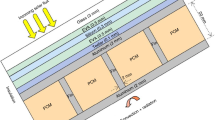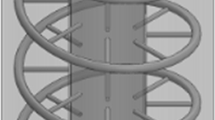Abstract
Heat energy storage equipment has the advantages of highly efficient energy storage performance and constant temperature owing to its adoption of Phase change material (PCM); however, its shortcoming is that it takes longer to complete thermal energy storage due to its low thermal conductivity. New technologies are being developed to overcome such shortcomings, including technology that would improve the heat transfer. This study is aimed at analyzing the impact on the energy storage time of the PCM via the Design of experiments (DOE) method and with changes to the following variables: The number of installed fins; the employed material (thermal conductivity); and the temperature of the supplied warm water, all by relying on Computational fluid dynamics (CFD). The PCM system is in the shape of a long vertical cylinder, with circular fins. The number of installed circular fins was one or five, the material used in the pipe and circular fins was changed from iron to copper, and the temperature of the warm water was 309.15 or 313.15 K. The thermal conductivity of each material employed for the CFD was 80.2 or 401.0 W/m-K. The DOE analysis was also performed to check for any curvature effect by adding a center point. The PCM used in this study is n-Octadecane 99% (CH3(CH2)16CH3) with its melting temperature being roughly 300.85 K. To sum up the conclusions of this study, the change in the number of installed circular fins and the temperature of supplied warm water have a substantial influence on the melting of the PCM. The change in the thermal conductivity of the pipe and circular fins has only a meager influence on the melting of the PCM. To reduce the melting time of the PCM most effectively, it is recommended to install as many circular fins as possible and to raise the temperature of the supplied warm water. This may be related to the fact that the melting of the PCM is influenced more by convection inside the PCM system rather than conduction.
Similar content being viewed by others
References
F. Agyenim, P. Eames and M. Smyth, A comparison of heat transfer enhancement in a medium temperature thermal energy storage heat exchanger using fins, Solar Energy, 83 (9) (2009) 1509–1520.
H. Shmueli, G. Ziskind and R. Letan, Melting in a vertical cylindrical tube: numerical investigation and comparison with experiments, International Journal of Heat and Mass Transfer, 53 (19) (2010) 4082–4091.
E. Assis, L. Katsman, G. Ziskind and R. Letan, Numerical and experimental study of melting in a spherical shell, International Journal of Heat and Mass Transfer, 50 (9) (2007) 1790–1804.
P. S. S. Srinivasan and M. Ravikumar, Heat transfer analysis in PCM-filled RCC roof for thermal management, Journal of Mechanical Science and Technology, 28 (3) (2014) 1073–1078.
F. Agyenim, N. Hewitt, P. Eames and M. Smyth, A review of materials, heat transfer and phase change problem formulation for latent heat thermal energy storage systems (LHTESS), Renewable and Sustainable Energy Reviews, 14 (2010) 615–628.
R. C. Reid, J. M. Prausnitz and B. E. Poling, The properties of gases and liquids (1987).
A. D. Brent, V. R. Voller and K. J. Reid, Enthalpy-Porosity technique for modeling convection-diffusion phase change: Application to the melting of a pure metal, Numerical Heat Transfer, Part A: Applications, 13 (3) (1988) 297–318.
Y. Cao and A. Faghri, A numerical analysis of phase-change problems including natural convection, Journal of Heat Transfer, 112 (3) (1990) 812–816.
ANSYS, Inc. ANSYS FLUENT User’s guide, Modeling Solidification and Melting, ANSYS Release, Setup Procedure, 14. 5 (2013) 26.1.
R. A. Fisher, The design of experiments, 4th Edition, Oliver and Boyd, Ediburgh (1947).
W. G. Hunter, J. S. Hunter and E. P. George, Statistics for experimenters An introduction to design, data analysis, and model building, John Wiley & Sons, Inc., New York (1978).
C. R. Hicks, Fundamental concepts in the design of experiments, Holt, Rinehart and Winston, New York (1973).
P. W. M. John and P. W. M. John, Statistical design and analysis of experiments, The Macmillan Co., New York (1971).
F. Yates, The design and analysis of factorial experiments, Imperial Bureau of Soil Science, Harpenden, England (1937).
S. Bell, Measurement good practice guide No. 11, A beginner’s guide to uncertainty of measurement, National physical laboratory, Teddington, Middlesex, United Kingdom 2 (2001).
N. R. Draper and H. Smith, Applied regression analysis, 2nd Ed., John Wiley & Sons, Inc., New York (1981).
R. A. Fisher, Frequency distribution of the values of the correlation coefficient in samples from an indefinitely large population, Biometrika, 10 (1915) 507–521.
N. L. Johnson and F. C. Leone, Statistics and experimental design: in engineering and the physical science, John Wiley & Sons, Inc., New York (1964).
J. Neter and W. Wasserman, Applied linear statistical models, R.D. Irwin, Inc., Homewood (1974).
G. A. F. Seber and A. J. Lee, Linear regression analysis, John Wiley & Sons, Inc., New York (2012).
Author information
Authors and Affiliations
Corresponding author
Additional information
Recommended by Associate Editor Jae Dong Chung
Uk-Hee Jung received his B.S. and M.S. degrees from the Korea University of Technology & Education and Korea University, Korea, in 2004 and 2008, respectively. He is currently a researcher in KITECH. His research interests are designs of turbomachinery, CFD, optimization techniques and experimental tests.
Joon-Hyung Kim received his B.S. and M.S. degrees from the Hanyang University, Korea, in 2005 and 2007, respecttively. Currently he is pursuing his research towards Ph.D. in Fluid Mechanics at the Hanyang University, Korea. And he is currently a researcher in KITECH. His research interests are the turbomachinery and CFD.
Jin-Hyuk Kim received his Ph.D. degree in Thermodynamics and Fluid Mechanics at Inha University, Korea, in Aug. 2013. He has been a Senior Researcher in Thermal & Fluid System R&BD Group, at KITECH, Korea. His research interests are CFD, the turbomachinery, optimization techniques and experimental tests.
Jong-Hyeon Peck received his Dipl.- Ing. degree from TU Clausthal (Germany) in 1993, and his Ph.D in Mechanical Engineering at the Chonbuk National University in 2015. He is currently a principal researcher in KITECH. His research interests are in thermal energy storage and heat pump system with renewable energy.
Chae-dong Kang received his B.S. degree from Kyunghee University in 1985 and his M.S. in Mechanical Engineering from KAIST in 1989. He is currently a Professor of the Department of Mechanical Engineering at Chonbuk National University. His research interests are in refrigeration, building HVACs, ice slurries and molecular simulation.
Young-Seok Choi received his B.S. degree from Seoul National University and his M.S. and Ph.D in Mechanical Engineering at the same university in 1990 and 1996, respectively. He is currently a principal researcher in KITECH. His research interests are the turbomachinery and CFD.
Rights and permissions
About this article
Cite this article
Jung, UH., Kim, JH., Kim, JH. et al. Numerical investigation on the melting of circular finned PCM system using CFD & full factorial design. J Mech Sci Technol 30, 2813–2826 (2016). https://doi.org/10.1007/s12206-016-0541-7
Received:
Revised:
Accepted:
Published:
Issue Date:
DOI: https://doi.org/10.1007/s12206-016-0541-7




